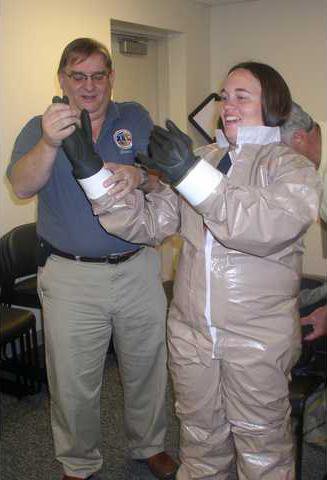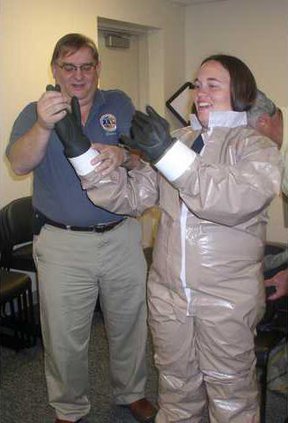HOISINGTON — Clara Barton Hospital held hazardous preparedness training for employees with Charlie Keeton, South Central Hospital Preparedness Regional Coordinator and Thomas Donay, lead instructor, last week. Around 15 staff members trained, including lab techs, nurses, radiology and administrators during the 16 hour program.
It’s “literally designed program to assist hospitals for response to disaster type incidents,” said Keeton. If the hospital is deluged with victims due to such incidents as a chemical fire, the hospital is ready to respond.
The hospital has a suite outside of the hospital designed to decontaminate victims and keep the hospital itself, staff and patients safe from any contamination. The training is also designed to prevent any disruption of service for current patients. The focus is removing contaminants so that the victims can be brought into the hospital.
There are 33 south central emergency preparedness care facilities in the south central region that agree to provide reciprocal emergency supplies and assistance to each other in the event of a large number of victims. There are seven regions in the state.
Great Bend Regional Hospital and Ellinwood District Hospital are critical partners for CBH, said Keeton. The cooperative members meet together once a month to communicate, network and share resources.
“They have a working relationship prior to the disaster,” said Keeton. “Things just flow better.”
CBH’s Paula Hofmeister and Jane Schepmann share coordination duties.
CBH has cache of supplies for such emergencies. Those also include emergency supplies such as those needed for setting up a command office are kept on hand as well as decontamination so that the facility can be returned to a normal state as soon as possible. Each hospital has its own cache.
The training also provides information about delivering appropriate care after removing contaminants.
The trainees will put the training to work in early September when they participate in a drill. Team members will be given the chance to test equipment and show others how it is used.
John Moshier, director of Human Resources, said that the training is good for a variety of positions. “It’s neat to see those with very different positions come together to work as a team.”
Depending upon the type of emergency will determine who is in charge of the incident.
“We stress that the person in charge, the instant commander, be the most experienced based on the incident,” said Keeton. He said that if there is an internal flood in the hospital, the commander could be maintenance so that the situation could be assessed and mitigated.
The Response Team training is a program that was created by the Center for Domestic Preparedness and sanctioned by FEMA and the Department of Homeland Security, which was begun after 9/11. A review for employees is provided periodically to update employees and train new ones.
Clara Barton Hospital trains staff for hazardous events





